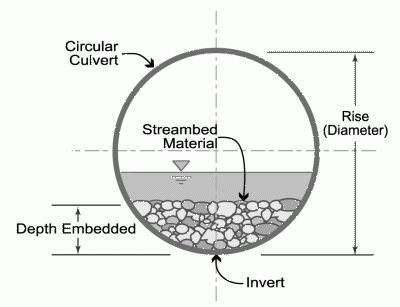Embedded Culverts |
Embedded culverts, also commonly known as sunken, countersunk, or depressed culverts, have their bottom placed below the streambed. This type of placement results in a culvert with natural substrate along the bottom, which increases the bed roughness resulting in lower water velocities. Embedded culverts can be circular, box, or pipe arches. Generally circular pipes are preferred since they allow for more vertical adjustment before exposing the pipe material at the bottom of the channel.
From a design and permitting perspective embedding a culvert qualifies as a streambed simulation option and eliminates the need to design for specific hydraulic criteria of an individual species of fish. There are currently few design guidelines for embedded culverts but research is ongoing. Design guidelines generally reflect the channel morphology where culvert size is based on a multiplier of the active channel or bankfull width. The sunken depth is usually 20% to 50% of the culvert diameter. Design and placement of the streambed material in the culvert and slope of the culvert requires a sufficiently long longitudinal channel profile and a bed material distribution analysis.

To evaluate embedded culverts in FishXing choose the Embedded option, specify a depth of embedment or a percent of the pipe diameter that is embedded and select a roughness factor that describes the stream bed material in the culvert. The sunken culvert option can also be used to model metal pipes with concrete-lined bottoms. Choose the Embedded option and enter the approximate depth and roughness of the concrete.
See also: Entering Embedded Culvert Data, Entering Roughness Coefficients, Roughness Factors
For additional references see:
Gubernick. R, Bates. K, Designing culverts for Aquatic Organism Passage: Stream Simulation Culvert Design. International Conference of Ecology and Transportations Proceedings , Lake Placid, NY. 2003
Gubernick. R, Clarkin. K, and Furniss. M, Site Assessment and Geomorphic Considerations in Stream Simulation Culvert Design. International Conference of Ecology and Transportations Proceedings, Lake Placid, NY. 2003